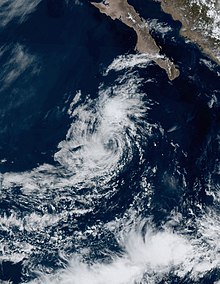Post-tropical cyclone
This article has multiple issues. Please help improve it or discuss these issues on the talk page. (Learn how and when to remove these template messages)
|

A post-tropical cyclone is a former tropical cyclone that no longer possesses enough tropical qualities to be considered a tropical cyclone.[1] The word may refer to a former tropical cyclone undergoing extratropical transition or a tropical cyclone degenerating into a remnant low. A tropical cyclone degenerating into a trough or wave, or having its low level circulation dissipate overland, lacks a cyclonic circulation and is referred as remnants instead of a post-tropical cyclone. However, post-tropical cyclones or remnants can continue producing high winds and heavy rains.[2]

Classification/Other post-tropical cyclones
Classes
Two classes of post-tropical cyclones exist
- tropical storm force.[1] Hurricane Paulette (2020) provides a recent example of an extratropical cyclone,[3] in which it no longer has a warm core in higher latitudes when it was over Nova Scotia and all points north in its trajectory.[4]
- Remnant low, which is non-frontal, has maximum sustained winds of less than 34 knots, and mainly consists of stable
Other post-tropical cyclones
Not all systems fall into the above two classes. According to the guideline, a system without frontal characteristics but with maximum winds above 34 knots may not be designated as a remnant low. It should be merely described as post-tropical.[7] A few examples falling into this grey area are listed below.
- Eugene (2011)[8]
- Michael (2012)[9]
- Nadine (2012)[10]
- Humberto (2013)[11]
- Joaquin (2015)[12]
- Matthew (2016)[13]
- Jerry (2019)[14]
- Paulette (2020)[15]
- Guambe (2021)
- Linda (2021)[16]
- Batsirai(2022)
- Emnati (2022)
- Blas (2022)[17]
- Frank (2022)[18]
- Howard (2022)[19]
- Kay (2022)[20]
However, there has been an occasion that the United States National Hurricane Center went against that definition and designated Calvin (2011) as a 35-knot remnant low.[21]
Also, if a tropical cyclone degenerates into a tropical wave or trough, then it does not qualify as a post-tropical cyclone. It would be referred as the "remnants of (tropical cyclone name)".
Formation
A post-tropical cyclone is formed when the typical characteristics of a
Impacts
The re-intensification of a post-tropical cyclone can cause dangerous conditions in North Atlantic shipping routes with high seas and winds comparable to those of
Origin
The terminology was initiated by Meteorologist Peter Bowyer of the Canadian Hurricane Centre in 1998 during Tropical Storm Bonnie.[25] In 2008, the National Hurricane Center used this term for Tropical Storm Laura to address the limitation of the two classes (extratropical/remnant low) mentioned above.[26] The term was later adopted by the National Weather Service on May 15, 2010.[7]
Synonym
The Bureau of Meteorology in Australia refers to a former tropical cyclone as an "ex-tropical cyclone".[27] An example is ex-tropical cyclone Oswald.
See also
References
- ^ a b c "Glossary of NHC Terms". www.nhc.noaa.gov.
- ^ "Glossary of NHC Terms". www.nhc.noaa.gov. Retrieved 2021-01-25.
- ^ "Post-Tropical Cyclone Dorian Forecast+Discussion". www.nhc.noaa.gov. Retrieved 2019-09-07.
- ^ "Dorian causing damage in Canada after losing 'hurricane' status". 8 September 2019.
- ^ Zelinsky, David A.; Pasch, Richard J. (2015-01-30). Hurricane Marie (PDF) (Report). Archived (PDF) from the original on 2022-12-17.
- ^ "Post-Tropical Cyclone MARIE". www.nhc.noaa.gov. Retrieved 2021-02-19.
- ^ Nws.noaa.gov. National Weather Service. January 15, 2010. Archived from the originalon October 30, 2012. Retrieved 13 October 2017.
- ^ "Post-Tropical Cyclone EUGENE". National Hurricane Center.
- ^ "Post-Tropical Cyclone MICHAEL". National Hurricane Center.
- ^ "Post-Tropical Cyclone NADINE". National Hurricane Center.
- ^ "Post-Tropical Cyclone HUMBERTO". www.nhc.noaa.gov.
- ^ "Post-Tropical Cyclone JOAQUIN". National Hurricane Center.
- ^ "Post-Tropical Cyclone MATTHEW". National Hurricane Center. Retrieved 2016-10-09.
- ^ "Post-Tropical Cyclone JERRY". National Hurricane Center. Retrieved 2019-09-28.
- ^ "Post-Tropical Cyclone PAULETTE". www.nhc.noaa.gov. Retrieved 2022-11-16.
- ^ "Post-Tropical Cyclone LINDA". www.nhc.noaa.gov. Retrieved 2022-11-16.
- ^ Reinhart, Brad (June 20, 2022). Post-Tropical Cyclone Blas Advisory Number 26 (Report). Miami, Florida: National Hurricane Center. Retrieved June 20, 2022.
- ^ "Post-Tropical Cyclone FRANK". www.nhc.noaa.gov. Retrieved 2022-11-16.
- ^ "Post-Tropical Cyclone HOWARD". www.nhc.noaa.gov. Retrieved 2022-11-16.
- ^ "Post-Tropical Cyclone KAY". www.nhc.noaa.gov. Retrieved 2022-11-16.
- ^ http://www.nhc.noaa.gov/data/tcr/EP032011_Calvin.pdf
- ^ "Saison 2012-2013" (in French). Météo-France. Retrieved 5 February 2018.
- ^ doi:10.1002/met.1410.
- ^ "Extratropical Cyclone". britannica.com. Encyclopædia Britannica. Retrieved October 27, 2016.
- ^ "Learn about hurricanes: Post-tropical cyclones". 16 June 2009.
- ^ "Tropical Storm LAURA". www.nhc.noaa.gov.
- ^ "Tropical Cyclone Outlook". Bureau of Meteorology.

